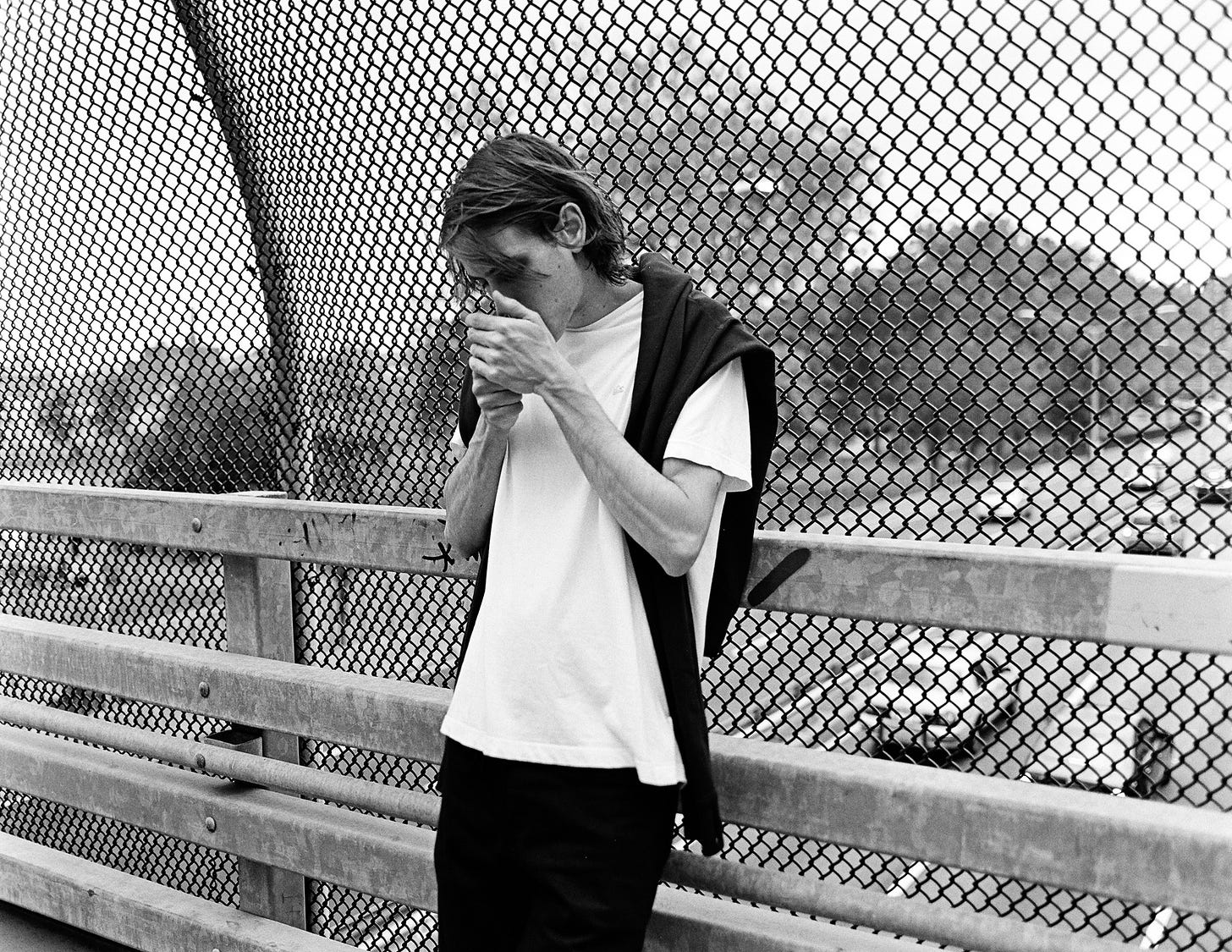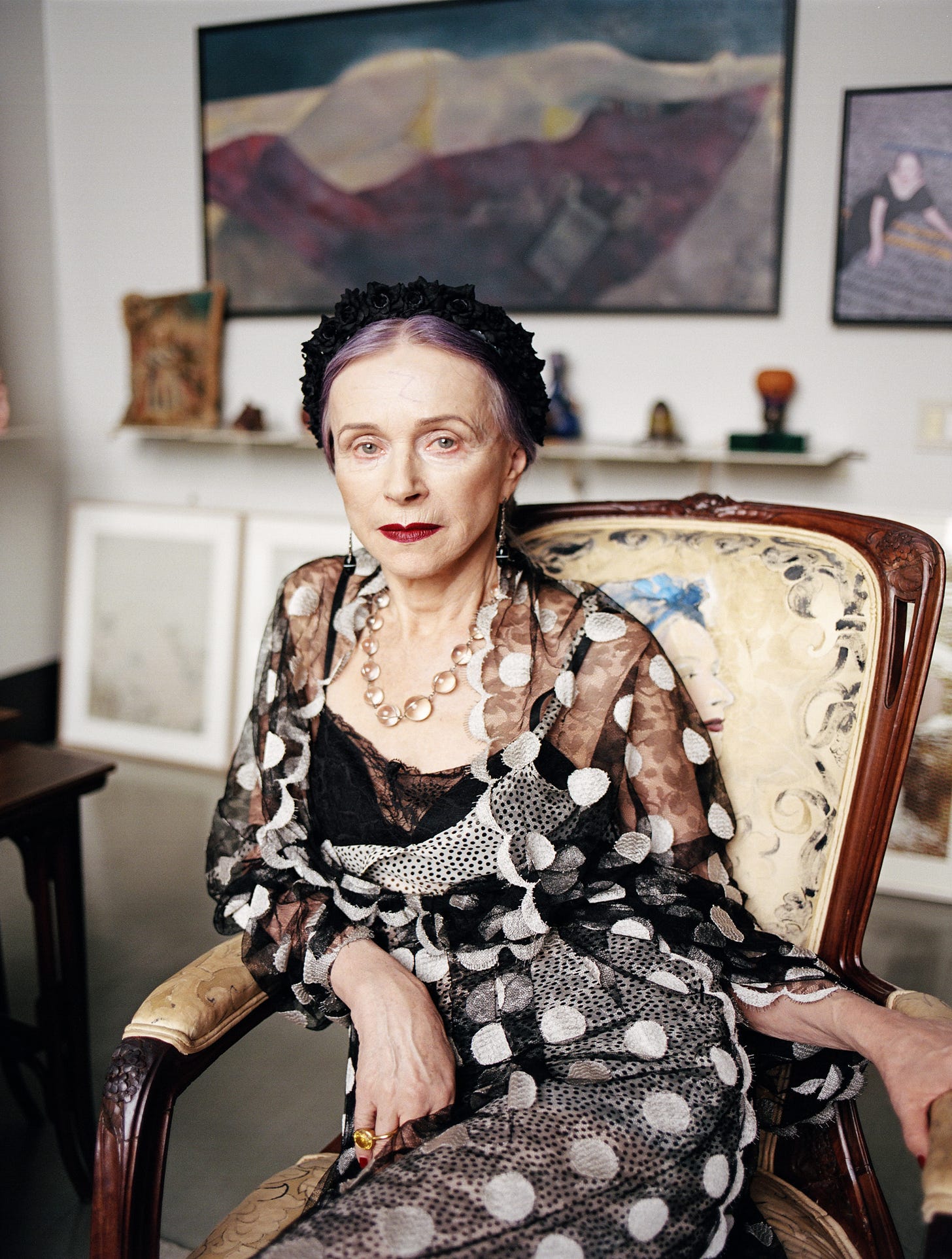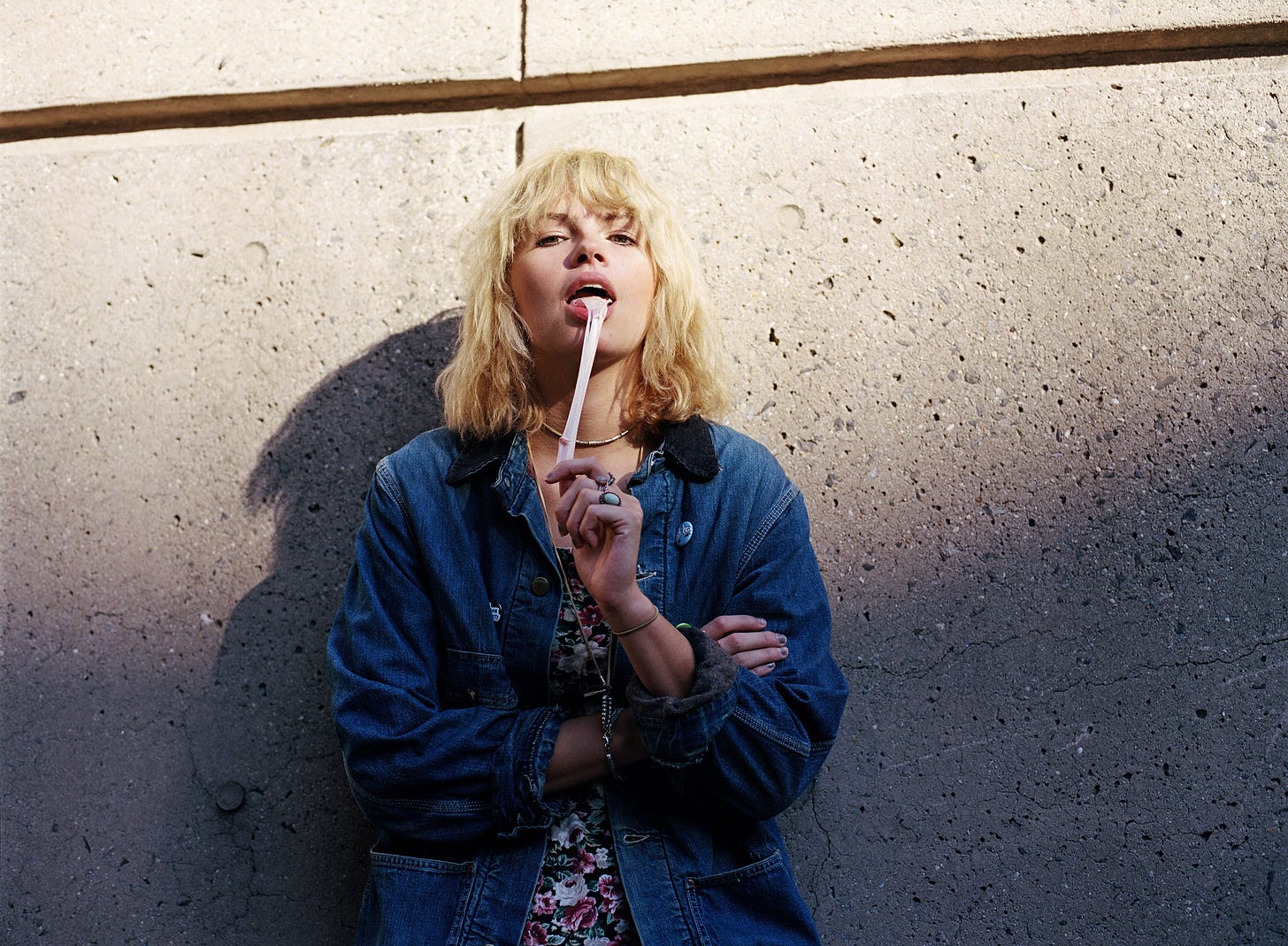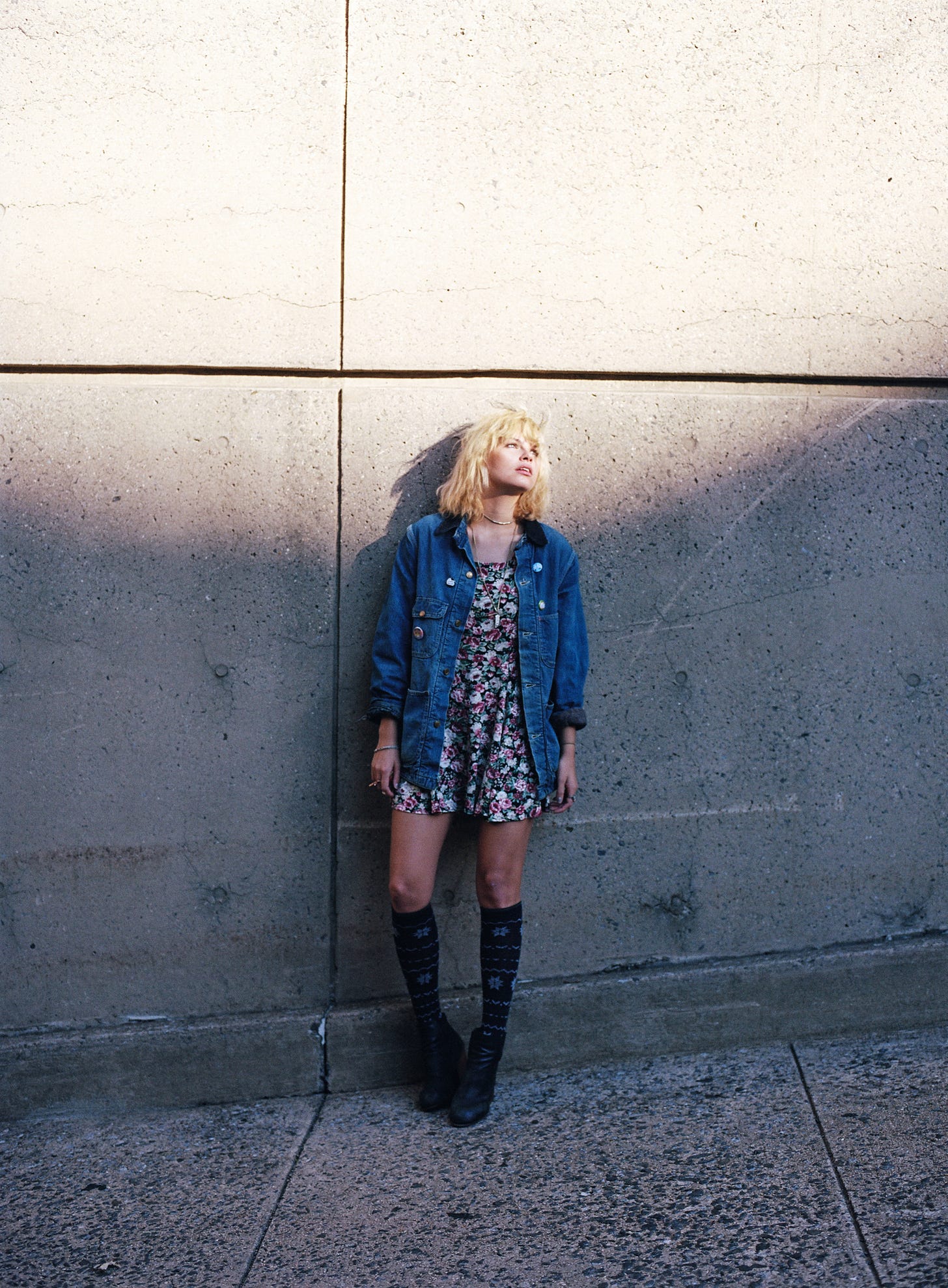There is a certain vulnerability that blooms when a subject is in front of a camera. A thread is drawn, and moments of discomfort unravel into intimate displays of beauty. If the shutter is pulled in that instant, it’s as though the photographer has captured the true, innermost being of their subject, different than the one portrayed in the flesh. A look of wildness or affliction is detected in the eyes, a softened state of repose in the mannerisms or body language. The camera lends the soul a place to stretch its limbs and dance, a sense of credence. I was here once. This was the world. A moment in time is held and suspended, forever encapsulating who a person was and who they will never be again, and something is arresting—some form of both faculty and surrender—in that.
In 2011, I moved to New York City from Los Angeles to pursue photography. I was twenty-three, sheltered, and hungry for a life of art. Though I had no idea what that meant at the time, I was influenced by the arresting portraits of Nan Goldin and her downtown milieu, the freedom and liberation of Ryan McGinley’s early photographs, and the sexually charged charisma of Nobuyoshi Araki’s motifs. It felt surreal to attend their shows in person, to photograph some of the muses they worked with, and to stumble with reckless abandon down the same streets they traversed. I landed in Bushwick first, like most twenty-something transplants at the time, eventually settling in the East Village on 11th and A where some of my first photographs were taken and where many memories were formed
The act of taking photographs is an anthropological study as well as a process of self-reflection. The camera served as a veil I could hide behind and surface from. The more I revealed about myself, my insecurities, or my emotions to my subjects, the more they felt at ease, sometimes even acting as a mirror. When I first started, I directed the people I photographed to look melancholy and wistful, perhaps because these are the emotions I've always felt the most familiar with. While I don't believe an inherent sadness is something to be celebrated, I do believe it is something to explore. I suppose that was what I was doing in those early days of taking photos. Exploring my sadness, and exploring the city until eventually imagination, fascination, and wonder became the most prevalent sensations that flowed through me.
In Laura Poitras’ staggeringly poignant documentary All the Beauty and the Bloodshed, Nan Goldin says in her cool, collected tone, “It's easy to make your life into stories. But it’s harder to sustain real memories.” When Poitras asks Goldin what she means by this, she doesn’t flinch. “Well, the difference between the story and the real memory. The real experience has a smell and is dirty and is not wrapped up in simple endings. The real memories are what affect me now. Things can appear that you didn’t want to see, where you’re not safe. And even if you don’t actually unleash the memories, the effect is there. It’s in your body.”
When I look back at photographs I took in Rockaway during the aftermath of Hurricane Sandy, I don’t register the scenes objectively at all. Instead, I remember the smell of burnt coffee people were selling out of silver pots for three dollars. The sharp cold and the scent of wet wood. I hear the valor in people’s voices who lost their homes and were already making plans for rebuilding. I feel the wind in my teeth as my former partner and I ride our bikes across the Williamsburg Bridge, the aureate lights of Brooklyn glimmering faintly, Manhattan a sea of black. I feel the water kiss my toes as we trudge through his flooded restaurant in Tribeca. I can still feel the heat of his body in the candlelight of our sixth-floor walkup. It is like running one’s fingers over a tender, bulging scar—imperfect, raw, anything but simple.
Equally, photographs can serve as an anodyne. A friend of mine left this world at the age of twenty-eight, and in the time just before he overdosed, his skin was pale, paper-thin, his eyes sunken and despondent. I cherish the photo I have of him where he’s reading on a chaise lounge next to a glowing swimming pool in the backyard, barefoot, sun-kissed skin, flanked by parched California palms. He looks like a supine angel, relaxed and smiling gently to himself. This is the way I like to remember him. When one is in a dark place, summoning photographs taken during a time of inspiration can convalesce—yank one’s shriveled heart out of its cave and back into the light. It is how we make sense of the world.
I was in a ravenous search for what stirred me as a photographer, a witness to the world. In the painter Agnes Martin’s ruminative stream-of-consciousness piece, “The Untroubled Mind,” she speaks of inspiration at the climax of her essay:
Many people as adults are so startled by inspiration which is
different from daily care that they think they are unique
in having had it. Nothing could be further from the truth
Inspiration is there all the time
for everyone whose mind is not clouded over with thoughts
whether they realize it or not
Most people have no realization whatever of the moments in
Which they are inspired.
Inspiration is pervasive but not a power
It’s a peaceful thing
It is a consolation even to plants and animals
Do you think that is unique
If it were unique no one would be able to respond to your work
Do not think it is reserved for a few or anything like that
It is an untroubled mind.In other words, inspiration is a thing shared by all sentient beings. A painter goes for a walk in the first thrush of spring, a cat watches a bird soar through the air and land on the windowsill, plants drink the light of summer and create sustenance, a chef inhales a scent in Naples and conceives of a dish that will forever remind him of Italy. Inspiration is a thing that hits us when we are doing simple things when we are in our beginner’s mind.
“If your mind is empty, it is always ready for anything; it is open to everything. In the beginner’s mind, there are many possibilities; in the expert’s mind there are few,” Shunryu Suzuki states in the prologue of Zen Mind, Beginner’s Mind. Here, we can be playful and explorative, allowing our minds to wander and absorb the pieces of everyday life that later imbue our consciousness with creative scintilla
A desire in most artists is the ideal of finding the perfect muse. Beatrice was the inspiration for Dante’s Divine Comedy. Alice B. Toklas was Gertrude Stein’s partner, editor, and secretary; her counterpart in conceiving of and hosting famous salons from their home on rue de Fleurus in Paris. Photographer Daido Moriyama took hundreds of moody, contrasted black-and-white photos of cats throughout his career. George Dyer appeared in over forty of Francis Bacon’s paintings, most famously “Triptych May-June 1973,” in which his lover is depicted as having intentionally overdosed on the toilet. Bacon continued to paint Dyer obsessively years after his death.
The director Olivier Assayas filmed Irma Vep in 1997, both starring and inspired by actress Maggie Cheung, who later “mysteriously vanished” from his life and turned her back on the world of filmmaking altogether. Assayas re-created Irma Vep as a series in 2022 and wrote a scene depicting a conversation he wished he’d had with her. Mrs. E.R. Senn, an elegant blonde woman in a mink coat whom Patricia Highsmith met briefly while working as a holiday salesperson in the toy department at Bloomingdales, was the basis for Carol in her novel The Price of Salt. Highsmith wrote about Mrs. E.R. Senn in her diaries and even went as far as to take the train to her home in Ridgewood, New Jersey, unannounced in hopes of seeing her again. There is something curious in the way muses continue to impel and haunt their obsessors.
I was fortunate enough to have found my muse only a couple of years into my journey in photography. Galvanized by a young woman who frequently appeared in photographs taken by Jonathan Leder (who I later found out was psychologically and sexually abusive), I reached out to her on Instagram, and shortly afterward we met outside of McNally Jackson Books in SoHo. She was like something out of a seventies film…airy and beautiful, her fuzzy blonde hair tangled in sunlight as she walked across the street in her cotton dress and silver-buckled leather boots. We wandered around the West Village, and I clumsily snapped some of the first photographs taken on my medium-format Pentax
Nola and I became instant friends. We shared our deepest, excruciating secrets, went to music and art shows together, and spent late nights talking, singing, and laughing. Most importantly, we created together. We dreamt of a bright future where we would tell our stories through writing and filmmaking. I had a primordial affection for her that manifested itself in many ways. One sublime, drunken afternoon in summer we held hands all over the city, kissed against parked cars in the dappled lemony sunlight of Saint Marks. Our love was a different kind of love, something that felt akin to making a painting come to life or evoking the characters in a novel. One that could only exist between two women during those credulous years of discovering themselves.
Having a muse was like waking every morning to the sunlight touching my face...it was routine, easy, domestic. When the two people on either side of the camera have their guards down, taking a photograph is as easy as blinking. But shortly after those golden days, having spent six years in the city, I simply couldn’t handle its grandeur anymore. I was broke, sick, tired, and could no longer afford my rent. As Joan Didion said in her 1967 essay about leaving New York, “It is distinctly possible to stay too long at the fair.”
During my last week of living in New York City full-time, I took the train from West Harlem down to MoMa to see Nan Goldin’s “The Ballad of Sexual Dependency.” In the dark, cavernous room surrounded by strangers, where Goldin’s saturated photographs flashed across the big screen to The Velvet Underground’s “I’ll Be Your Mirror,” I wept. The tears did not come from a place of sadness, but from a well so deep in me it’s difficult to describe. The Japanese have a word for it, which I now have tattooed on my collarbone: Yūgen. Though it isn't translatable into English, it is often described as profound beauty and mystery, or lingering memory.
Photography taught me empathy. It taught me to see things as they were while also imagining the possibility of what they could be. By looking at old photographs, I often find myself discovering truths that were not apparent to me at the time. Could it be these dazzling enigmas, these vaults of ephemera are so inherent to certain moments in time, so tethered to certain people, that persisting to encapsulate them elsewhere is futile?
I realize now, after all these years, that the photographs weren’t the point. As it is often said of life, it’s the journey that shapes us, and it is those fledgling years—where I was playing, exploring, becoming—that I look back on with a sense of wonder and a heavy heart.
Jenna Putnam is a writer and visual artist born in Maui and living in California. Drawn to concepts that blur the line between the documented and the surreal, she is constantly exploring relationships between concrete thought, memory, and the subconscious. Her writing and photography have appeared in Autre, Hero, ExPat Press, The Moth, Pidgeonholes, The Sun, The New York Times, and others. Her poem “The End (pt. II)” was nominated for a 2023 Pushcart Prize, and her screenplay Northern Lights was a quarterfinalist for the 2023 Outstanding Screenplays Feature Competition. She is the author of the poetry collection, Hold Still (Paradigm Publishing), and directed the short film, Agathe, in 2021. She has exhibited, read, and performed at venues and galleries in California, New York, and Shanghai.










Jenna, this is a masterpiece that I will hold in my heart for a long time to come. Thank you.